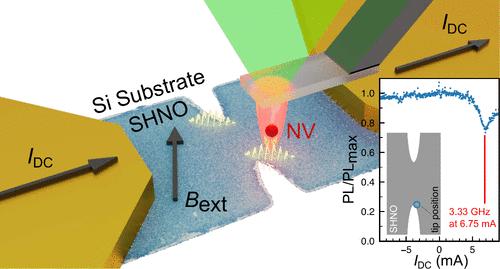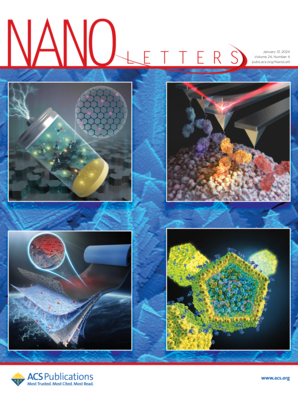Nanoscale Mapping of Magnetic Auto-Oscillations with a Single Spin Sensor
IF 9.6
1区 材料科学
Q1 CHEMISTRY, MULTIDISCIPLINARY
引用次数: 0
Abstract
Spin Hall nano-oscillators convert DC to magnetic auto-oscillations in the microwave regime. Current research on these devices is dedicated to creating next-generation energy-efficient hardware for communication technologies. Despite intensive research on magnetic auto-oscillations within the past decade, the nanoscale mapping of those dynamics remained a challenge. We image the distribution of free-running magnetic auto-oscillations by driving the electron spin resonance transition of a single spin quantum sensor, enabling fast acquisition (100 ms/pixel). With quantitative magnetometry, we experimentally demonstrate for the first time that the auto-oscillation spots are localized at magnetic field minima acting as local potential wells for confining spin-waves. By comparing the magnitudes of the magnetic stray field at these spots, we decipher the different frequencies of the auto-oscillation modes. The insights gained regarding the interaction between auto-oscillation modes and spin-wave potential wells enable advanced engineering of real devices.

单自旋传感器磁自振荡的纳米尺度映射
自旋霍尔纳米振荡器在微波状态下将直流电转换为磁自振荡。目前对这些设备的研究致力于为通信技术创造下一代节能硬件。尽管在过去十年中对磁自振荡进行了大量的研究,但这些动力学的纳米尺度映射仍然是一个挑战。我们通过驱动单个自旋量子传感器的电子自旋共振跃迁来成像自由运行的磁自振荡的分布,从而实现快速采集(100 ms/pixel)。利用定量磁强计,我们首次实验证明了自振荡点定位于磁场最小值处,作为约束自旋波的局部势阱。通过比较这些点的杂散磁场的大小,我们破译了自振荡模式的不同频率。关于自振荡模式和自旋波势阱之间相互作用的见解使实际设备的先进工程成为可能。
本文章由计算机程序翻译,如有差异,请以英文原文为准。
求助全文
约1分钟内获得全文
求助全文
来源期刊

Nano Letters
工程技术-材料科学:综合
CiteScore
16.80
自引率
2.80%
发文量
1182
审稿时长
1.4 months
期刊介绍:
Nano Letters serves as a dynamic platform for promptly disseminating original results in fundamental, applied, and emerging research across all facets of nanoscience and nanotechnology. A pivotal criterion for inclusion within Nano Letters is the convergence of at least two different areas or disciplines, ensuring a rich interdisciplinary scope. The journal is dedicated to fostering exploration in diverse areas, including:
- Experimental and theoretical findings on physical, chemical, and biological phenomena at the nanoscale
- Synthesis, characterization, and processing of organic, inorganic, polymer, and hybrid nanomaterials through physical, chemical, and biological methodologies
- Modeling and simulation of synthetic, assembly, and interaction processes
- Realization of integrated nanostructures and nano-engineered devices exhibiting advanced performance
- Applications of nanoscale materials in living and environmental systems
Nano Letters is committed to advancing and showcasing groundbreaking research that intersects various domains, fostering innovation and collaboration in the ever-evolving field of nanoscience and nanotechnology.
 求助内容:
求助内容: 应助结果提醒方式:
应助结果提醒方式:


